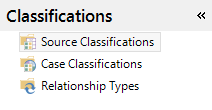About classifications
In NVivo, you use classifications to store descriptive information about your sources or about the people, places or other cases in your project. You can then use this information to make comparisons or to gather material by attribute. This topic gets you started with classifications— for more information, refer to Classify sources and Classify cases.
If you have NVivo Pro or NVivo Plus, you can work with source classifications.
In this topic
- What are classifications?
- Working with case classifications
- Working with source classifications
- What is a classification sheet?
- What are relationship types?
What are classifications?
Classifications provide a way to record descriptive information about the sources, nodes and relationships in your project:

While source and case classifications behave in a similar way, they are used for different purposes:
-
Use case classifications to provide demographic details about the people, places or other cases in your project. For example, classify a node as a Person and define attributes for age and occupation.
-
Use source classifications to store bibliographical information about your sources—you can import this information from reference management tools like EndNote or Zotero. NVivo also provides the predefined classifications interview and focus group to help you keep track of your sources—you can add these to your project or create your own general classifications. (NVivo Pro and Plus only)
For more information, refer to Classify cases (set attribute values to record information) or About classifying sources.
Relationship Types are a special type of classification—they let you describe the nature of the relationship (development 'impacts' water quality). Refer to About relationships types for more information. (NVivo Pro and Plus only)
Working with case classifications
When you click on Case Classifications in Navigation View, you will see the case classifications that are available in your project:
-
Person
-
Organization
-
Community
If you cannot see any classifications, then you may want to
Each case classification has its own unique set of
attributes. For example, if you expand the classification Person
you can see the attributes that are available for recording:
-
Person
-
Age
-
Gender
-
Occupation
As you classify your cases, you can specify an 'attribute value' for each attribute:
| Attribute | Value |
| Age | 25 |
|
Gender |
Male |
| Occupation |
Cattle farmer |
Working with source classifications
This feature is available in NVivo Pro and NVivo Plus.
When you click on Source Classifications in Navigation View you will see the classifications that are available in your project:
-
Email Message
-
Newspaper Article
-
Journal Article
-
Web Page
If you cannot see any classifications, then you may want to:
-
Import a literature review from a tool like EndNote or Zotero.
-
Add any of NVivo's predefined bibliographical classifications—if you intend to use a reference management tool to format your references later on.
-
Create your own classifications (or add NVivo's predefined classifications Interview or Focus Group)—if you want to keep track of your sources.
Each classification has its own unique set of attributes.
For example, if you expand the classification Newspaper
Article you can see the attributes that are available for recording:
-
Newspaper Article
-
Reporter
-
Year
-
Title
As you classify your sources, you can specify an 'attribute value' for each attribute:
| Attribute | Value |
| Reporter | Benjamin Smith |
| Year | 2010 |
| Title | Urgent Challenges of Climate Change |
When you import data from a reference management tool, the sources are automatically classified and the attribute values are assigned.
When you import web pages or import content from Evernote or the NVivo Add-In for OneNote, the sources are automatically classified as 'Reference'. Attribute values—for example, the URL and title of the web page—are assigned.
What is a classification sheet?
When you have classified your sources or cases, you can open a grid that displays the attributes for all items in a particular classification—this grid is called a classification sheet.
For example, you could open the Person classification sheet and see all the cases in this classification. The cases are displayed along with their attribute values—you can sort and filter the cases based on their attribute values (for example, age and gender). You can also update attribute values via the classification sheet.
Refer to About classification sheets for more information.
What are relationship types?
This feature is available in NVivo Pro and NVivo Plus.
In Navigation View, under Classifications, there is a folder for relationship types—relationship types are a special type of classification.
Relationship types describe the nature of a relationship (node) that occurs in your project. For example, you could set up a relationship type married and another relationship type lives with.
Unlike other classifications, relationship types do not have attributes—when you create a relationship type you need only define the direction of the relationship (associative, one-way, or symmetrical).
Refer to About relationship types for more information


 Top
of Page
Top
of Page